Best running watches 2024
Take these into the zone with you.

1. At a glance
2. Best overall
3. Best budget
4. Best battery
5. Best for professionals
6. Best Android
7. Best health tracker
8. FAQ
Whether you're a couch-to-5K runner, marathoner, or somewhere in the middle, you'll find plenty of watches and trackers to fit any workload or preference. An Apple Watch or Wear OS watch will give you some basic fitness functions along with lifestyle apps for a more well-rounded experience.
But the best running watches prioritize sensor accuracy, advanced fitness features, and durable battery life above apps and smarts. Starting with the Garmin Forerunner 265, we've tested and chosen the best running tech that caters to your passion for running.
At a glance
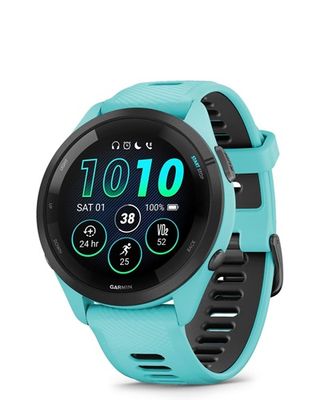
Best overall
Whether you're an enthusiast marathoner or a professional athlete, the Garmin Forerunner 265 is the best running watch for you.

Best budget
Amazfit makes specialized tools more accessible with the budget-friendly Cheetah Pro. Don't be fooled by the price, the watch has loads health and training features.

Best battery
COROS delivers the best battery life on a wearable designed for running with the APEX 2 smartwatch. You get 17 whole days without GPS, and 40 hours with it.
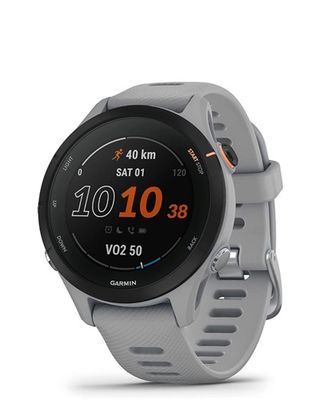
Best for professionals
Elites in the running sector will gravitate towards the premium Garmin Forerunner 955. This smartwatch features impressively advanced tools to help you stay on top of your game.
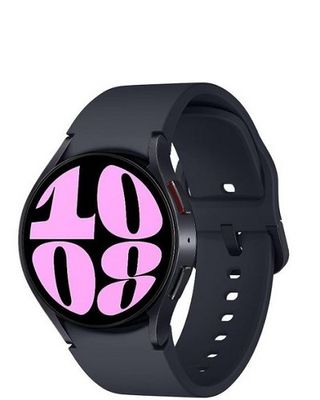
Best Android
Need a watch for running to go with your Android phone? The Samsung Galaxy Watch 6 is the best such wearable, running Wear OS 4 out of the gate.
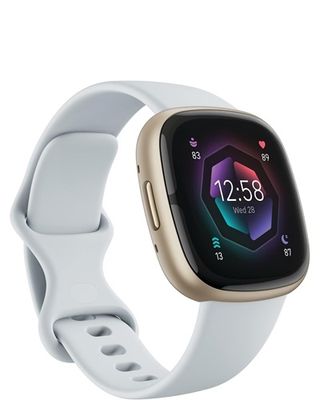
Best health tracker
The Fitbit Sense 2 serves as an extensive health-tracking tool, bringing you advanced features and sensors such as ECG, cEDA, and more.
Best overall

Reasons to buy
Reasons to avoid
For years, the Garmin Forerunner 245 was Android Central's #1 pick thanks to its reliable health and location tracking, along with tools like Garmin Coach that keep you on the right training path. Then the Forerunner 255 took its place with key upgrades like heart rate variability, all-systems multi-band GNSS, and new widgets like a Morning Report and Race Widget that made training planning easier.
I bring up these watches first because the Garmin Forerunner 265, our pick for the best runners watch, is only a "prettier 255," as my review described it.
You're getting the same experience for $100 extra, in terms of analyzing your form, performance, and heart health to help recommend your future workouts and recovery times. Both are fantastic devices, and when you compare the Forerunner 265 vs. 255, the latter has 95% of the same tools.
So why do I recommend the Forerunner 265? Because the 416 x 416 AMOLED display is significantly more readable than the memory-in-pixel (MIP) displays on most running watches. The 265 is beautifully bright and ensures using your watch indoors isn't an eye-straining chore. It also lowers the battery life compared to bulkier Forerunners, but 20–24 GPS hours is still above average.
We also appreciate its one exclusive upgrade over the 255: Training Readiness. An update to the Body Battery stat, it uses HRV status, sleep data, and acute load to measure your muscles' recovery time in addition to your body's overall energy. So you'll never be told to run when your body is sore, just because you slept well.
Ultimately, this is one of the most comprehensive watches for self-guided runners to improve their PRs and VO2 Max scores. The Forerunner 965 is better, but the 265 has a slightly more reasonable price and has all the core tools most runners need.
Best budget
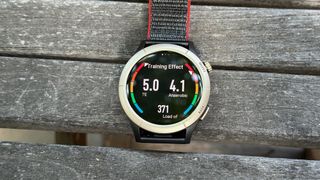
2. Amazfit Cheetah Pro
Our expert review:
Reasons to buy
Reasons to avoid
Shopping for the best running watch doesn't automatically mean you need to spend a fortune. The Amazfit Cheetah Pro comes with core features like built-in GPS, heart-rate monitoring, activity/sleep tracking, sports apps, energy monitoring, and stress tracking. It trades off features like NFC, but it has all the essentials for a much lower price than most running smartwatches.
As our Cheetah Pro review explained, the lightweight Amazfit smartwatch packs plenty of value for money. You get extremely accurate GPS tracking, Alexa onboard, the ability to answer calls on your wrist thanks to the mic and speakers, as well as local music storage. The wearable can last for around two weeks on a single charge, so the battery life is excellent.
Apart from all the necessary health and fitness tracking sensors, the Amazfit Cheetah Pro also comes with the brand's proprietary AI Zepp Coach. Just like any decent Garmin watch, it uses AI to create a recovery plan and helps you understand how much rest time you need between workouts.
If you want to go even cheaper, the Amazfit Cheetah Round is a stripped-down version of the Cheetah Pro with almost the same features. It's a decent cheap alternative to consider.
Best battery
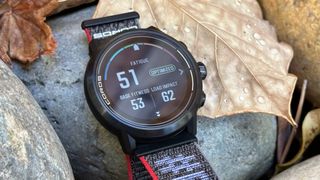
Reasons to buy
Reasons to avoid
Most people are happy enough with a watch that lasts one day under normal circumstances, while last-gen running watches often only lasted 10-20 hours with GPS tracking enabled, or relied on solar panels to last longer. The COROS APEX 2 can last a whopping 45 hours per charge, ensuring it'll never die on you even if you start a workout with low battery levels.
COROS is a popular brand among many runners, and in recent years it has developed significant software tools like an EvoLab for measuring training effect and recovery time and a Training Hub for getting training plans to improve your times. If you're only familiar with Garmin watches, you shouldn't sleep on the APEX 2, which gives the Forerunner 265 a run for its money (no pun intended).
It has a titanium frame and sapphire glass, giving the APEX 2 a more premium appearance than most plastic-heavy running watches (like most Garmin watches). Otherwise, I appreciated that it has both a touchscreen and digital crown for whichever type of navigation you prefer, though some runners will prefer Garmin's specific Up and Down buttons to a dial.
The APEX 2 has blood oxygen and ECG detection — though you can only spot-check this information rather than run it continuously. And it uses all-systems GNSS tracking, meaning it relies upon multiple satellite systems at once to detect your positioning more exactly, in case your signal is blocked from a specific direction.
Technically, the better option for battery life is the COROS APEX 2 Pro, which lasts a whopping 75 hours per charge and offers other "pro" upgrades like increased storage and dual-frequency GPS tracking. But we recommended the APEX 2 over the Pro in our review, noting that it's a better deal for its lower price point. COROS lowered the APEX 2's price after launch, making it $100 less than the Forerunner 265 at full price.
Best for professionals
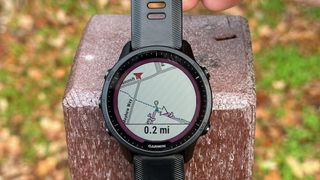
Reasons to buy
Reasons to avoid
When we first reviewed the Garmin Forerunner 955, we called it the "best runner's watch, period." Since then, the Forerunner 265 and 965 have complicated the discussion. I'm currently reviewing the Forerunner 965, which (like the 265) is a more expensive 955 with an AMOLED facelift. Keep that in mind when you're making your choice; but until that review goes live, the 955 is still my recommendation.
The Forerunner 955 is a bigger but more polished version of our former top pick, the Forerunner 255. Its bulky design comes partially from its impressive battery (42 GPS hours is nearly unmatched, aside from the COROS APEX 2 Pro) and a 1.4-inch MIP display.
I especially loved its Training Readiness perk during my review period, but now Garmin is bringing the tool to other Forerunner and Instinct watches. Still, the Forerunner 955 has other exclusive features, starting with a real-time stamina bar that shows your estimated energy left so you don't overtrain. It also tells you how quickly you're acclimating to high heat or altitude, taking that data into account for workout suggestions.
It has a whopping 32GB of storage for both music and maps — including preloaded topographical maps, golf and skiing maps, and room for uploaded GPX maps, which more adventurous runners will find incredibly useful. You can see Strava Live Segments on your wrist during a run, or if you choose a route in advance, the Climbpro feature will preview what kind of elevation gain to expect moving forward.
Best Android
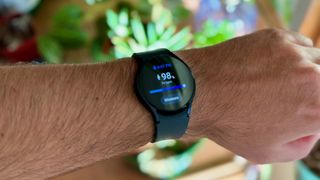
Reasons to buy
Reasons to avoid
Most of the best running watches put much more stock in running coaching and health data than traditional "smartwatch" features that require a battery-guzzling processor. But some runners really don't want to compromise on smarts and will accept a shorter battery for better functionality. In that case, pay close attention to the Samsung Galaxy Watch series.
The Galaxy Watch 6 and Watch 6 Classic sport an Exynos W930 chipset with 2GB of RAM for silky-smooth performance and app support that most other runners' watches can't offer. That includes Wear OS apps like Strava, Adidas Running, Nike Run Club, and so on; you can directly access these running apps instead of having to export data to them from apps like Garmin Connect.
Both the Galaxy Watch 6 and Watch 6 Classic watches have a gorgeous super AMOLED display with a touch bezel for scrolling through menus, with a physical rotating bezel on the Galaxy Watch 6 Classic. And they all share a bevy of health sensors that measure everything from your heart's health and rhythm to your overall body composition (aka fat and muscle percentage) and blood oxygen.
You get the same all-day battery life on both Watch 6 series devices as their battery specs are the same. Where other Wear OS watches and the Apple Watch could die after just a few hours of GPS tracking, the Galaxy Watch 6 is much more dependable to handle that, continuous HRM, music storage, and so on without instantly dying. Unfortunately, the tradeoff for this battery life is that it's hard to get past just how heavy this watch is as a runner used to lighter devices.
The Galaxy Watch 6 is the best Android smartwatch we've tested, giving you plenty of perks outside of fitness to enjoy, while still giving plenty of perks for casual runners striving to achieve their goals.
Best health tracker
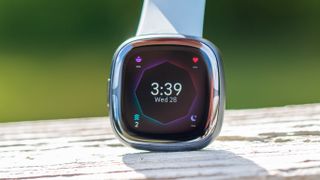
Reasons to buy
Reasons to avoid
Some people run for the joy of running; others because it's the simplest way to get your heart and body healthier. If health is your main concern, or if you spend as much time in the gym as hitting the pavement, you may want to opt for a Fitbit instead. The Fitbit Versa 4 is the more affordable watch, or you could switch to a tracker like the excellent Charge 5 instead. But the best Fitbit for health tracking is the flagship Fitbit Sense 2.
The Sense 2 comes with one of the widest ranges of health sensors available, tracking your heart rate, rhythm, and variance, blood oxygen, and skin temperature. With Fitbit Premium, you'll get various reports on your Daily Readiness, overall health, stress levels, health trends over the last 90 days, possible issues like fevers or AFib, and other useful tools and scores.
Our Fitbit Sense 2 review explains the many perks that come with this model, starting with the attractive "squircle" design with AMOLED touchscreen and the new side button that replaces the finicky capacitive button of the original Sense. Its reliance on a touchscreen makes it less reliable than button navigation when your fingertips get sweaty, but it's undoubtedly a lighter, more attractive watch for casual wear outside of runs. And you'll get good everyday mileage out of tools like tap-to-pay, Amazon Alexa integration, and even Google Maps support.
In terms of fitness features, you get essentials like heart-rate monitoring, sleep tracking, automatic exercise recognition, on-screen workouts, and female health tracking. And you'll love Active Zone Minutes, which shows the time you spend in fat burn, cardio, or break heart-rate zones.
You don't get any super-advanced features here as far as running is concerned, and the six-day battery life doesn't match other options on this list. Plus, it only has 5 hours of estimated GPS tracking, well below the other options on this list — plenty for casual runners who won't run longer than an hour or so, but not enough for all-day tracking.
How to choose the right running smartwatch for your needs
When shopping for the best running watch, there are several factors to consider, including your battery life needs, feature preferences, and budget. Most dedicated runners will find the Garmin Forerunner 265 to be their best option, whether you prioritize price and battery life or display quality and the latest software. Regardless, Garmin watches give you great running guidance at no extra charge.
Before you choose your running watch, make sure that you're committed to using that software to amp up your running performance and endurance. Otherwise, you may just want a traditional smartwatch until you're sure you are committed. A Galaxy Watch gives you the essentials, and lets you export data to popular third-party running apps where you can get useful maps and analysis.
Not everyone needs a watch that lasts for weeks, since it could mean missing out on smarter tools or more attractive designs. But if you want something on the other end of the spectrum, anything from a COROS to a Fitbit could give you the health and fitness focus that you want.
Be an expert in 5 minutes
Get the latest news from Android Central, your trusted companion in the world of Android

Namerah enjoys geeking out over accessories, gadgets, and all sorts of smart tech. She spends her time guzzling coffee, writing, casual gaming, and cuddling with her furry best friends. Find her on Twitter @NamerahS.
